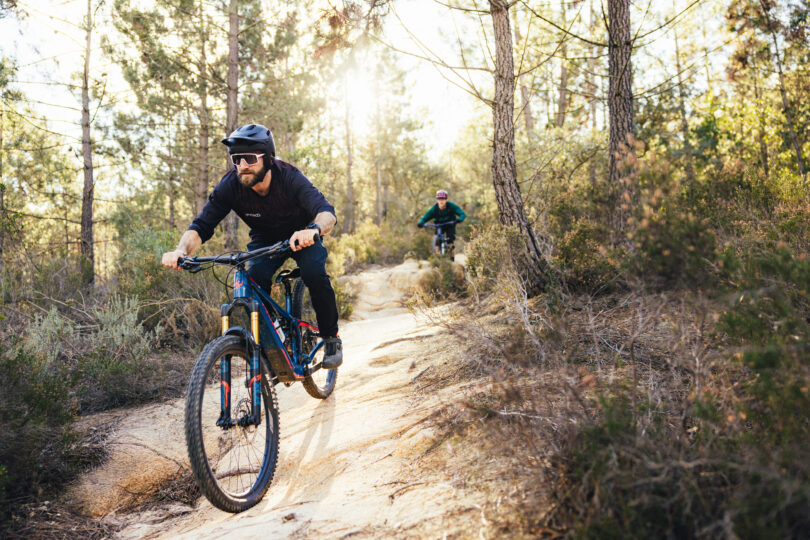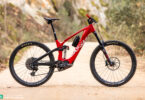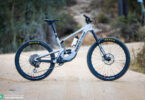Characteristics and fields of application of the e-mountain bikes in our group test – explained in detail
Characteristics:
Design
unbalanced / coherent
As you know, we all have different tastes, and we’re very happy to debate about them over lunch 😉. But while we might not all agree on the paint job and colour, good eMTB design language is based on clear, objective principles: are the lines and proportions balanced and aesthetically pleasing? Does it have visual and functional accents? Have the motor and its components been integrated sensibly and seamlessly?
User friendliness
cumbersome / clever
Our evaluation of user friendliness includes many aspects of handling the eMTB when we’re not on the trails. This includes things like how easily the charging port and battery are accessible. Can the battery be removed for charging? Do you need a tool or a key to do so, or can you just grab it and go? If you need a tool to remove the battery, has the manufacturer thought of integrating a multitool into the bike? How neatly arranged and intuitive are all the controls and remotes on the cockpit? Are there any aids for setting up the suspension? The weight also plays a role. How easily can you carry the eMTB up the stairs and into your apartment or pick it up onto your bike rack?
Value for money
terrible / excellent
Value for money is not about finding an eMTB with the most expensive components at the most competitive price. What matters is how much fun, performance, design, and quality you get for your money. An experienced company can build a more harmonious bike with cleverly chosen, affordable components than an inexperienced company who only spec the most expensive components. If you can find a coherent package for the intended use that fits the character of the eMTB, only then will it perform as it should. If it’s well-priced, you’ve got good value for money.
Trekking and commuting suitability
low / high
The trekking and commuting suitability includes your daily commute to work as well as outings at the weekend or overnighters in inclement weather and poor visibility. In these instances, you want practical accessories like lights, eyelets for mudguards, or bosses for tool bags and the like. A navigation unit and integrated anti-theft protection are nice to have too – whether via GPS, digital immobilisation with an alarm, or just a lockable battery.
Handling
demanding / intuitive
This is mainly about how intuitive, balanced and predictable the bike rides. The best bikes are loyal companions in all conditions, easy for both beginners and experts to control, whether at high or slow speeds. This isn’t just a lot of fun but also ensures longer riding pleasure and less fatigue because you can always rely on your bike to behave as expected. On the other side of the spectrum, you’ve got the divas that suddenly change their character in certain situations, or when pushing the limits, and they can only be reined in by a very experienced rider. Experts may see this as an exciting challenge, but beginners will quickly feel overwhelmed or get thrown off!
Fun factor
boring / lively

Intended use:
Gravel roads
Gravel road use requires plenty of long-distance comfort, which results mainly from a relaxed and ergonomic riding position, comfortable yet efficient suspension, and powerful yet easy-to-modulate assistance. It entails riding on level terrain, uphill, downhill, on poorly maintained roads, and woodland paths.

Technical climbs
When speaking of technical climbs, we mean uphill trails over roots, rocks and other obstacles. Tight corners and loose ground require a very well-balanced bike. It’s mainly about how well the bike keeps tracking through key sections and assists the eMTB rider to overcome obstacles with finely modulated support. The suspension must be efficient without getting bogged down, but it must still hug the ground to generate sufficient traction.

Flowtrail descents
Flow trails are typically defined by long corners with berms, moderate gradients, and rollable obstacles on which it’s easy to find good flow. An eMTB is suitable for flow trails when it’s willing to get airborne and actively invites you to play with the terrain thanks to its sprightly and agile character.

Technical descents
If just looking at the descent gets your adrenaline pumping, you know what we’re talking about. Demanding singletrack and shaped tracks, littered with obstacles and roots, as well as fast, open corners, which can occasionally be rough, too. Here, what you want from your bike is lots of reserves, lots of traction, and a high level of composure.

Did you enjoy this article? If so, we would be stoked if you decide to support us with a monthly contribution. By becoming a supporter of E-MOUNTAINBIKE, you will help secure a sustainable future for high-quality cycling journalism. Click here to learn more.
Words: Peter Walker Photos: Diverse








